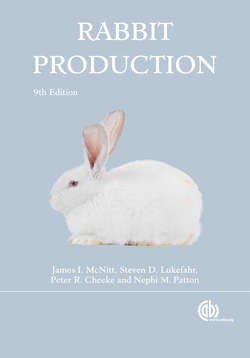Читать книгу Rabbit Production - James I McNitt - Страница 69
На сайте Литреса книга снята с продажи.
Sanitation
ОглавлениеSanitation is very important in controlling disease. Ideally, cages should be cleaned daily. Any manure hanging on the bottoms of cages should be removed with a wire brush. This helps control enteritis and hepatic coccidiosis. A wire brush mounted on a long handle is a handy tool. A battery-driven electric drill with a wire brush head can be mounted on a handle and used for cleaning the bottoms of cages. A plastic toilet-bowl brush will be less damaging to the galvanizing on the wire but will need more frequent replacement. Cages may be brushed or sprayed with a bleach solution (30 ml of bleach per liter of water). Disinfectants are effective only on the surface, so cages must be thoroughly cleaned to remove attached dirt prior to disinfecting. Rabbits excrete large amounts of calcium carbonate in their urine; calcium deposits may build up (Fig. 5.18). Calcium carbonate is soluble in acid, so a mildly acidic solution (e.g., vinegar) will aid in removing these deposits.
Fig. 5.18. An example of a deposit of calcium carbonate in a rabbit cage. Rabbits excrete large amounts of calcium in their urine. (Courtesy of OSU Rabbit Research Center)
Hair should not be allowed to build up on cages and elsewhere in the rabbitry (Fig. 5.19). Hair can be removed from cages by burning with a propane torch. Be careful with a torch, as it can be a fire hazard. Do not use a torch to burn hair or cobwebs off the ceiling or walls. A vacuum cleaner may also be used for removing hair.
Fig. 5.19. Accumulation of hair on cage bottoms. (Courtesy of D.J. Harris)
Flies in the rabbitry are a nuisance. It is conceivable that they could be vectors in the spread of diseases such as pasteurellosis, but this hasn’t been proven. In an urban or suburban area, the rabbit raiser can be the target of legal action if the rabbitry is the neighborhood source of flies. Flies can be controlled by the use of screens to keep them out of the rabbitry and by the use of baits and spraying programs to eliminate them if they do gain entrance. Such management procedures as repair of leaky water valves are important to keep the manure habitat as dry as possible. (This also helps minimize ammonia production.) Insecticides can be of the organophosphate type, such as malathion, or of the natural type, such as pyrethrum products (obtained from the pyrethrum flower). Spray contact with the rabbits should be mini-mized-especially with organophosphates. A good rule of thumb is to use only spray products that are safe for use around lactating dairy cattle. Another method of fly control is the use of natural fly predators, such as beetles and wasps, that can be purchased from commercial sources. The naturally occurring black soldier fly, Hermetia illucens, is also beneficial for fly control in the rabbitry. The females, about the size of wasps, live on nectar from flowers and only enter the rabbitry to lay eggs. They fly close to the ground, lay their eggs in the manure pack, and leave. The larvae are about 2 cm long and are a dirty gray color. They out-compete the filth fly larvae (primarily houseflies and stable flies) for food and will reduce the numbers that hatch. They also will reduce the volume and water content of the manure pack. They are very active and will result in the manure pack moving into the aisles each night. Shoveling the material back under the cages each day is a small price to pay for good fly control.
Growing earthworms in the manure pack will also help keep filth fly populations under control by stirring and drying the manure. However, moisture requirements for worms are much higher than are generally advisable for rabbits, so growing worms under the rabbits may result in increased incidence of pas-teurellosis and other respiratory diseases.
A white fungus is often observed on the manure beneath the cages (Fig. 5.20). It is probably harmless, although it is possible that spores released by mature fungi could contribute to respiratory disease of the rabbits. It can be controlled if desired by application of a fungicide to the manure.
Fig. 5.20. A white fungus is often observed growing on rabbit manure beneath the cages. (Courtesy of P.R. Cheeke)
